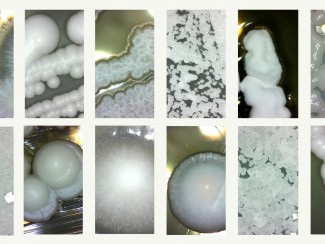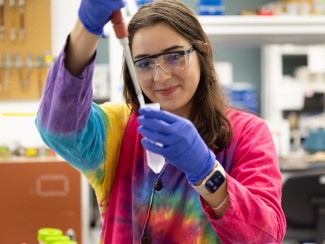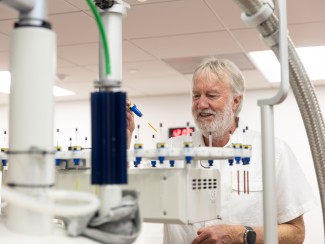
We have talked about the basics of bioenergy and how we access energy from plants, but how does this fit into our lives? In the last episode of our series on bioenergy, we focus on how exactly biofuels fit into our lives and ways they have already made an impact. We speak to researcher Tyler Lark about the big picture of biofuels in the United States, from past and future policy to its effects on the ecosystem.
Do you have a question about energy in Wisconsin? Ask the Wisconsin Energy Institute at communications@energy.wisc.edu or tweet us and tag #WattsUpWI.
Listen to Watt's Up, Wisconsin? on Apple podcasts, Spotify podcasts, Google Podcasts, Youtube, or anywhere you find podcasts.
Guests
 Tyler Lark, Assistant Scientist, Center for Sustainability and the Global Environment, Nelson Institute of Environmental Studies, University of Wisconsin–Madison
Tyler Lark, Assistant Scientist, Center for Sustainability and the Global Environment, Nelson Institute of Environmental Studies, University of Wisconsin–Madison
At SAGE, Tyler leads research on U.S. agricultural land-use change and its impacts on our nation’s land and water resources. He received his Ph.D. from UW-Madison’s Nelson Institute Environment & Resources program in 2017 for his research on America’s changing “Food- and Fuel-Scapes” and today continues to explore issues at the intersection of land use, bioenergy, and food production.
Credits
 Britta Wellenstein, Host
Britta Wellenstein, Host
Britta is a Wisconsin Energy Institute communications intern and UW–Madison undergraduate majoring in Life Sciences Communication and Environmental Studies.
This episode was produced by Britta Wellenstein and Michelle Chung.
Theme music by Eden Comer.
Transcript
Britta Wellenstein: When you pull up to a gas station,
[car engine starts]
Britta Wellenstein: You may notice E-15 or E85 as options. These options are blends of the typical fuel you pump into your car and a biofuel, either bioethanol or biodiesel. Biofuels are derived from plants and have a lower carbon emission than fossil fuel based sources. They're seen as a necessary part of reducing emissions in the transportation sector.
But how did these biofuels end up blended with the gasoline we pump into our car? And how will these biofuels play a role in our future? Today on Watt’s Up, Wisconsin, we're finishing off our series on bioenergy by understanding how these biofuels fit into our lives.
[light switches on]
Britta Wellenstein: You're listening to Watt’s Up, Wisconsin brought to you by the Wisconsin Energy Institute, where we explore your questions on energy in Wisconsin. I'm communications intern, Britta Wellenstein.
[cow moo]
Previously on Watt’s Up, Wisconsin. We spoke to Great Lakes Bioenergy researcher Cullen Vens about bioenergy crops, following how the energy from the sun makes its way to a plant. We then spoke to graduate student Ben Hall about the microbes we use to eat up these plants and create compounds we can use for products and fuels.Today we turn away from our cute little microbes and photons and turn to the big picture of biofuels. To learn more about this, I spoke to Tyler Lark, researcher at the Center for Sustainability and the Global Environment at the University of Wisconsin-Madison. He's an expert in agricultural land use, conservation and federal policy.
Britta Wellenstein: Before the series, we talked about the basic science of bioenergy and biofuels. We talked about a lot of benefits of that. But what do you see The benefits of bioenergy?
Tyler Lark: I think the potential upsides are huge, and that's why people have been interested in it for a long time. And we continue to have interest in it as a society and a group of scientists. One of the main ones right now is the potential to help mitigate climate change. So we have this huge, urgent, pressing need to reduce carbon emissions, and bioenergy has that potential, both to displace fossil fuel usage and potentially, depending on the types of feedstocks that we use, store extra carbon in the soil as well.
So I think a lot of potential there, but also benefits. It's been bioenergy has been promoted from an energy independence standpoint and supporting rural livelihoods in economy. So so it's been touted for many different dimensions, a lot of opportunity there, and just those are the things that we want to think about as we evaluate different bioenergy systems.
Britta Wellenstein: Can you talk a little bit more about that energy independence?
Tyler Lark: Yeah, I think that was floated a lot, maybe a decade or two ago when we really expanded bioenergy production in the United States and liquid transportation, biofuels in particular. It was a time when, you know, there was uncertainty and turmoil in the Gulf and a lot of oil exporting countries and interest in promoting homegrown energy sources, and this was about the time or right before fracking got really big, so we didn't have all those sources looking for alternatives to petroleum, essentially. And so if you can grow something here in your own country, I think politicians had an idea that that would be a beneficial thing to pursue.
Britta Wellenstein: The first push for biofuels came in the 1970s when domestic production of crude oil declined and import prices rose. Producing domestic bioethanol as an additive to gasoline would decrease the dependence on foreign oil. This bioethanol was produced from corn and is often just called corn ethanol. Throughout the seventies and eighties, oil price shocks and government incentives increased the production of corn ethanol and its blending into gasoline.
Adding ethanol to gasoline increases engines performance and reduces tailpipe emissions. Ethanol also replaced an engine booster that had significant emissions and negative health impacts. Today, 98% of fuels have ethanol blended into them. Typically 10% ethanol and 90% gasoline, which is known as the E85 blend. But other blends contain more ethanol, like E15, which is 15% ethanol. However, the biggest push for ethanol production came in 2005 when Congress passed the renewable fuel standard.
Tyler Lark: Right now in the United States, there's this really just one large biofuel policy. It's called the Renewable Fuel Standard. It was passed back in 2005 and then greatly expanded in 2007, and it essentially mandates that a certain level of biofuels need to be blended into our transportation fuel supply. So that's where to date it's been mostly corn ethanol that's been mandated and blended in.
But they actually had aspirations to include all these other things like cellulosic biofuel. So things made from native and perennial crops that we talked about, like switchgrass or other grasses.
Britta Wellenstein: The renewable fuel standard, the RFS, was the primary driver for the increase in ethanol production. There are two major types of bioethanol corn ethanol, as we've discussed, and cellulose ethanol made from nonagricultural crops like waste or crop residues or dedicated energy crops like the sorghum and switchgrass, Cullen and Ben research. The majority of bioethanol production is corn. Almost 94%, according to the Department of Energy, is corn ethanol.
Although there are benefits to using corn as a biofuel, Tyler's research has shown the unintended downsides of corn ethanol.
Britta Wellenstein: Moving away from the benefits–so I've talked to the researchers about challenges in converting bioenergy crop fuels from a molecular level, literally just trying to get microbes to eat the ligands to create the energy. But your research looks at that a lot more broadly and how this actually impacts us. So what do you see as the challenges in biofuels?
Tyler Lark: Yeah, I think a lot of it stems down to the land use, right? We have this one single land base and all these competing demands for it, whether it's growing crops for animal feed or for food or for bioenergy, as well as all these other potential uses. Right. Increase development in housing or agrivoltaics or wind production.
And so ultimately, in my sense, in the frame that I look at it from, it comes down to the land and those competing tradeoffs. And so we want to think about if we use some land for bioenergy production or to grow a crop that could land gets used for for biofuels, what does that look like compared to those alternative uses?
You know, if we would have been growing a different crop or if we would have been grazing cattle on that land, and how do the environmental outcomes of those uses compare.
Britta Wellenstein: Then your I know your research has specifically looked at corn based ethanol and that land use switch corn ethanol isn't something that we talked about. The other researchers because they're more focused on perennial and annual plants. Could you give me a little bit of background in corn ethanol?
Tyler Lark: Yeah. So corn ethanol, for better or worse, is is really makes up for what we've produced in the United States as far as biofuels so far. So I think it's something like 90% of all bioenergy or at least bio–liquid biofuels that we've produced thus far have come from corn ethanol. And corn is great in a lot of senses, that it's really highly productive, and it's also a really versatile crop. So you can use it for animal feed. You can make all kinds of food products, other, you know, plastics from it, anything really, including ethanol, which is a nice liquid transportation fuel. And so for that reason, corn ethanol has kind of risen to the top as the key biofuel we've produced thus far.
On the flip side, corn is a really intensive agricultural production system, so it requires a lot of inputs or things like nitrogen, fertilizer and pesticides and labor. And, it's also a very leaky system. So a lot of those nutrients that we apply to a corn field, for example, that help it grow. A lot of those return to the environment through the forms of nitrate leaching down into groundwater or perhaps its surface runoff into our surface lakes and rivers, and there it can do things like flow downstream where it leads to hypoxia or the dead zone in the Gulf of Mexico. So we have all these environmental externalities that are sort of associated with this really productive cropping system.
Britta Wellenstein: And then there's also the land conversion aspect as well. So what are some of those emitters from converting normal land into what would be corn?
Tyler Lark: Yeah. So corn is a production system, has all of its pros and cons and tradeoffs. And then another thing we want to think about as we dedicate any land source to the biofuel production or something else is what are the unintended consequences. And so if we are converting a bunch of our land to corn production, whether it's existing cropland that might have been growing oats or alfalfa or wheat, and we change that to corn, or if we convert other land types, so like grassy pastures or semi-natural lands or conservation set aside lands to produce more crops for biofuels, what are the outcomes of those land changes as well?
And so we know and typically when you plow up something like a perennial grassland, if it was a pasture conservation, grassland and plant and annually cultivate a crop like corn. In general, that's going to release some carbon emissions from that ecosystem that have been stored up in the soil or in the biomass. And so when you include those broader land use changes, we see that dedicating a huge new amount of land for something like corn ethanol can have some of these unintended consequences where you've also shifted that overall landscape towards a much more intensive one.
Britta Wellenstein: So then by switching it from something, you're like releasing carbon. It's not necessarily–it's not necessarily storing it like we like, we think it is.
Tyler Lark: Yeah, exactly. If you convert a carbon rich ecosystem into one that's a little bit more productive and extractive, like like corn in general, you'll probably lose a little bit of that ecosystem carbon that was stored.
Britta Wellenstein: In 2022. Tyler and other researchers published a study looking at the impact the RFS had on cropland conversion. They found that the RFS increased the area of land harvested for corn by 7 million acres since 2008. As much as corn ethanol itself is better than a fossil fuel based source. This conversion of land, especially from native grassland to corn, results in carbon emissions. Prairies that had been growing for hundreds of years were taking in carbon and storing it in the undisturbed soil and roots.
By converting land, we are releasing some of that stored carbon. More crops also resulted in more pollution from fertilizer or increased soil erosion, a decrease in biodiversity and endangered some species.
Britta Wellenstein: And then, as you said, like most of our biofuels that we're creating are from corn-based ethanol. But a lot of the research at the GLBRC is more focused into those native annual and perennial. There's obviously downsides to corn based ethanol, but then how does that compare to biofuels we create from these native animal or perennial plants like sorghum and switchgrass?
Tyler Lark: So I think there's a lot of potential there. Corn has been around for a long time. It's had basically a century of research and development investment in that technologies that support it and the associated infrastructure and some of these next generation biofuel feedstocks, things like native perennial grass systems, like switchgrass or a mixed native grass prairie have really only had, you know, significant investment and research into them for the last decade and a half, two decades, and, you know, a little bit before that.
And so they're really young. And we've already made as a scientific community, I think, huge breakthroughs in the potential or so. I think they're really young and nascent and there's a huge potential if those could mature, to actually reap and realize all these benefits that we want to get from any energy system but bioenergy in particular, right? So we could store more carbon in our environment, we could continue to displace fossil fuels, but also using some of these native and perennial crops, avoid some of those unintended consequences or negative externalities that we see with corn right now.
And so something like a native perennial crop like switchgrass. You know, one of the big benefits is you have this living vegetation on the landscape year round. You got roots in the ground, and so when the snow melts in spring or you have heavy rainfalls, you don't have all this exposed bare nude soil and have soil erosion running off, you're sequestering carbon for a longer period throughout the year.
So a lot of potential, I think, of upsides of the next generation biofeedstocks.
Britta Wellenstein: Then that being said, where are we currently with those next generation feedstocks? Is that going to be the future of biofuels or is it still going to be set on corn?
Tyler Lark: I think it's the whole, you know, that's hard to predict what the future will look like. And, you know, right now we have a pretty robust corn ethanol industry. So I think that industry probably is going to say it's not going anywhere. But I think the hope is we can continue to improve any bioenergy industry that we have right, so if it is the existing corn ethanol that we have in place, can we add conservation practices to its production to reduce the carbon intensity of the fuel that's produced from it? Or can we integrate that in the landscape in a little bit more diverse and holistic and heterogeneous manner?
And that's where I think these next generation native and perennial plants really have a lot of potential because if you could intersperse those or even replace some of the existing annual crops with those, all of a sudden, you could still get this really productive and economically valuable and society beneficial bioenergy product, but start to realize some of those environmental benefits as well.
Britta Wellenstein: Would that switch– that was kind of going to be my next question is, what can we do with all these corn ethanol plots so that the best option would be converting them into something like a perennial?
Tyler Lark: You know, it probably depends who you ask. And that's, in a sense, sort of up to the US voters and policymakers. But, you know, from an environmental scientist, land use scientist perspective, you know, if you could replace an intensive annual crop with a bunch of native perennial crops, that would look great on the landscape and do wonders for things like water quality, wildlife habitat. Yeah, and really all around. So that would be, I think, a pretty desirable future. How far away we are from that, if that's ever possible, who knows? But as I said, that vision, I think that's why it's important that we keep investing in looking at some of these alternatives and figuring out what role they could have, how they might be able to fit into our existing agricultural systems, especially as we continue to move forward and as we look at things like electrification come in.
We know there's also still some really hard to electrify parts of the transportation sector. And so there's probably going to be a role for biofuels moving forwards, at least for the foreseeable future, and so making them as environmentally friendly, as sustainable as possible is going to be a key part of having a sustainable energy portfolio.
Britta Wellenstein: You mentioned that part of the fuels and areas and industries that we're going to keep needing fuel because there's some industries that we can't necessarily electrify right away. So could you speak to some of those?
Tyler Lark: Yeah, If you think about aviation, there's one that jumps up really hard to support aviation on the electrification or some people say, you know, shipping or long haul trucking are ones that are a little bit harder. Having a really energy dense liquid transportation fuel is in general, I think, foreseen by a lot of people, is going to be continue to have a need for that, at least to some extent throughout next 30 years or so.
Britta Wellenstein: Kind of switching back to what you're saying about perennial, annual, what do you say to a farmer who's possibly growing corn ethanol right now or is looking to change to to a bioenergy crop? Is it as economical to grow a perennial one, or is corn the best option in terms of what a farmer should do with their land?
Tyler Lark: Well, I would say a lot of our research and research on this topic in general, you know, we're looking big picture in policy, so the farmers are doing actually generally a great job at stewarding their land to the best of their ability. And what they're doing is responding to these market indications or these policy incentives. And so to farmers, I'd say keep doing what you're doing and maybe seek out opportunities. You know, there's a lot of great programs from the USDA and other agencies to add in conservation practices to land, you know, maybe want to restore a little bit of native grassland, and there's this great program on the Conservation Reserve program where you can get paid to essentially not plant a row crop and restore it to a perennial grassland.
There's other programs to keep your plants working and to enroll in the Conservation Stewardship Program or the Environmental Quality Incentives Program, which can do things like help provide the incentives and technical assistance to implement cover crops or vegetated buffers along your waterways. So there's all kinds of great opportunities out there that you can just layer in and fold in on your current production systems.
So I'd say look towards those. And even ethanol refineries and, you know, networks and folks working on that are always looking at how they can reduce the carbon intensity of that end product. And so trying to integrate more of these climate smart practices. So I'd say seek out those opportunities, keep going for them, and then for our policymakers–well, that's where I think we want to focus and say, okay, how are these policies structured right now? And are we getting the outcomes that we want from them? And if not, how do we tweak them so that we can Congress passed this, you know, Renewable Fuel Standard 15 years ago and set out a vision for the next 15 years and now we're there.
We've seen it. We've gone to the end of that statutorily mandated volumes. And, you know, there's discussions of, you know, what that might look like moving forward. And so just this summer, summer 2023, the EPA essentially took over prescribing what those different volumes are and now set volumes of different biofuels that we need to blend and produce each year moving forward.
Britta Wellenstein: This is a continuation of the renewable fuel standard from 15 years ago and looks forward to the next two years of biofuel production. The set volumes call for an increase in cellulose biofuel and other advanced biofuels from now until 2025, and the same production of conventional corn ethanol.
Britta Wellenstein: And that being said, where do you see biofuels sitting in the next few years? What's the future look like?
Tyler Lark: Well, it's actually a pretty I don't know, exciting time maybe? It's in flux. I think people aren't sure to what extent they're going to grow or stay at their current levels. There's a lot of growing interest in continuing to reduce our carbon intensity of all our transportation fuels. And so people are looking for solutions. They're looking towards things like biofuels as a way to supply sustainable aviation fuels.
Right? And so there's potential large growth in that and in some ways other sustainable fuel pathways. And so there could be another surge of interest in all types of biofuels, including some of these more first generation ones from corn and soybeans. And I would hope, you know, we don't lose that goal or vision as a society about what some of the better benefits could be if we're able to shift towards some of the more native and perennial type of feedstocks.
We are really in need of climate solutions immediately and and beyond just reducing our total emissions. At this point, all the IPCC projections suggest that in fact we're going to like overshoot where we need to be if we want to keep global warming to one and a half or two degrees Celsius, and so we're going to need some carbon dioxide removal technologies, right?
Somehow we have to draw down not only do we have to prevent and end our, you know, fossil fuel emissions, we have to draw down some of the existing carbon dioxide from the atmosphere, too. And for better or worse, these land-based climate mitigation technologies, if you call them that, so things like reforestation or restoring grasslands or bioenergy are some of the most mature carbon dioxide removal technologies that we have.
Right? We can use plants to draw down carbon from the atmosphere. And so as we look towards those natural climate solutions, as people often call them, a lot of them are great. They have co-benefits for the environment. But a challenge with some of them is that they saturate over time. So as the carbon stocks of that ecosystem, once it's restored, start to reach what the natural ecosystem might have looked like as a forest starts to mature, that rate of carbon sequestration starts to saturate or plateau, and so if we need carbon dioxide removal in perpetuity moving into the future, I think that's a really nice area where bioenergy might have a real significant role because as you continue to harvest that biomass that is produced, you can continue to offset fossil fuel emissions, while also still, say, store carbon in the ground through the soil and sequestration.
And so I really think theoretically there is a really nice role for bioenergy if we can get it right, you know, if we can grow and develop these feedstocks that are a little bit easier on our landscapes and add all these extra benefits that we that we want to achieve. Then, I think there's a nice little fit there for bioenergy in our kind of overall portfolio, and that's sort of the goal of a lot of what we're looking at here at the Great Lakes Bioenergy Research Center and I think in the U.S. and globally as a society about the potential for bioenergy.
Britta Wellenstein: I want to say what you said to make sure I understand. And because when you put together the carbon sequestration methods like reforestation, all those kind of restoration aspects, I didn't, I never would have thought that bioenergy was lumped into that group because there's one that you see as we're restoring this, and then we're kind of not touching it again or maybe maintaining it and that.
But bioenergy is something that you maintain and you harvest every year and you do all of that. So because you're harvesting it every year and it still has, usually, roots in the ground that are holding that carbon in, but then it's growing again. The next year it's sequestering still again, and not just you plant it once and leave it and then it can plateau. This doesn't plateau.
Tyler Lark: We want to look at to the best of our ability, like what are the tradeoffs and what are the benefits that we can get from these different systems and and just these more traditional, you know, restoration based ones maybe, or like natural land management based ones planting trees or reforesting or restoring grasslands or better managing our croplands and grasslands and things like that, those all have great benefits and some immediately tangible ones that we can search for and go on and get, and I think bioenergy is almost just looking at almost if you can do it right, those same types of systems, but just with a little bit more, maybe a slightly more intensive management, right? So instead of planting it and letting it go on its own. If we're thinking about a grassland, grasslands often need disturbance to to be maintained.
And so what if you want to grassland, but then you come back and harvest it every couple of years to maintain that disturbance, but then you also harvest that biomass, and if you could harness that then for bioenergy, well then you get this energy product that can offset other emissions elsewhere. And you still have that grassland that's on the landscape perennially and and year round and get all those benefits.
So I think that's kind of the idea and conceptually how it fits in with some of these other restoration-based natural climate solutions.
[music]
Britta Wellenstein: Thanks for listening in. Do you have questions about energy? Wondering how new energy solutions are taking off in Wisconsin? Let us know by sending an email at communications@energy.wisc.edu or tweet @uwenergy and tag #WattsUpWI




